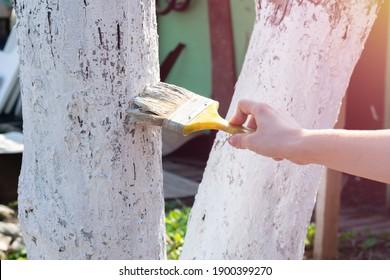Whitewash on trees protects from sun, pests
Q. We were driving along Corrales Road this past weekend and I noticed a “young” orchard where all the small trees had their trunks painted white. We wondered why and could only think that it was for some sort of tree identification done by the owner. Can you enlighten us as to why all the baby tree trunks are painted white? – N.D., Albuquerque
A.The tree trunks in that young orchard have been painted white for two reasons.
First, the whitewash on the trunks will help prevent the trunks from suffering sunscald. Here in this clime, we do enjoy some pretty terrific weather, and during the winter months, sometimes the sun does warm up a dormant tree’s trunk enough to get some sap moving. Then it’ll invariably get truly cold and as that freshly moved sap freezes, it can create cracks or fissures all along the trunk.
By painting the trunks with whitewash, the sunlight is reflected and the trunk isn’t as likely to heat up. The goal is to keep the trees more dormant. It’s a very smart and easy way to keep the trees healthier.
An additional reason you whitewash tree trunks is pest prevention. Brushed all over the trunk, the whitewash fills in nooks and crannies where several types of trunk-loving insect larva are looking for easier access into the trunk. And if there has been any sunscald damage, easier access for insects.
Any young fruit-bearing or ornamental fruit tree will benefit greatly from being whitewashed. It might look a bit funky but gives the trees a healthier leg up.
So what do you use to whitewash? That’s the easy part. Mix up equal parts water and white latex paint. The whitewash will look a bit thin, but it doesn’t take really thick coats to repel bugs and offer protection from the sunburn. I recommend scraping away the soil, exposing the trunk down about three inches below grade, and starting there, paint the whole trunk to the first major limbs.
Be sure to daub thoroughly any nooks and crannies covering the trunk completely. Allow the paint mixture to dry, then scooch the soil back to the trunk.

Why latex paint, you ask? Well, latex, with its plastic properties, will expand without cracking. Don’t use an oil-based paint as that could, in a sense, poison the tree. Use latex paint only for this project. You can also find tree whitewash online and at nurseries with a proper pharmacopeia.
So that’s why you are seeing that young orchard wearing a coat of white. The owner is doing all in their power to protect their investment, aiming for healthier trees in the long run.
Q. Out for our Sunday drive on the back road to Santa Fe, my native-born husband stopped and cut me some of what he says is mistletoe from an old juniper tree. Where I come from, mistletoe is green, wears plump longish leaves and has white berries. This stuff he gathered for me is a shocking chartreuse green color, mostly leafless and had only a few puny berries. Is what he gathered really mistletoe? – C.B., Albuquerque
A.Welcome to New Mexico, and yes, the stuff your beau gathered is in fact mistletoe.
So tie a festive ribbon around it and get it hung for the holidays.
Mistletoe was thought to have magical properties because of its nature of staying so green (even chartreuse green) during the deepest winter imaginable. During the dark part of the year, having a magic plant in the home to help the calling back of the sun was always a good thing.
Just please after your holiday cleanup, pitch the mistletoe. Don’t compost it, don’t add it to the collections you’re gathering for the next green-cycle event and don’t burn it.
Mistletoe is a parasitic plant, meaning it attaches itself to other trees and like a leach, will suck life out of its host tree. As the berries dry and expel the spore contained in the berry, it floats to a new tree, or host, and sets up house being a freeloader forever.
So be enchanted by the mistletoe so lovingly gathered for you this holiday season and then dispose of it properly. No need to spread more.
Happy Diggin’ In!
Tracey Fitzgibbon is a certified nurseryman. Send garden-related questions to Digging In, Albuquerque Journal, 7777 Jefferson NE, Albuquerque, NM 87109, or to features@abqjournal.com.







